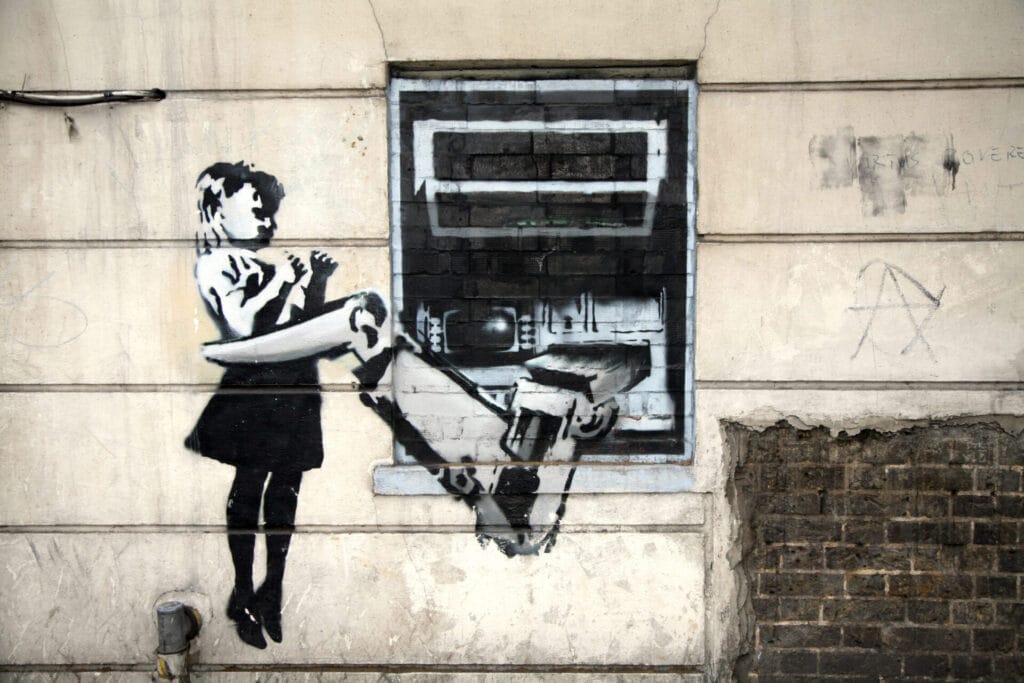Banksy is an enigmatic figure shrouded in mystery, with his artwork and identity inspiring passionate debate everywhere.
For decades, speculation has run rampant as to who he is and where he comes from, with each piece of new art raising further questions. But while this mystery may never be solved, we can gain unique insight into his work by taking a closer look at the art itself.
In this article, we will be exploring Banksy’s art in greater depth. We will examine his signature style, looking at recurring motifs and themes that can be seen across a variety of works. We will also look at the potential influences that have shaped Banksy’s esthetic and how it has evolved over time. Finally, we will explore the impact of Banksy’s work on modern culture and why it has resonated so strongly with people around the world.
What Is Banksy and His Art?
Banksy is an anonymous street artist from the UK whose artwork has sparked global fame and controversy. His pieces, which are often politically and socially charged, are known for their dark humor and wit. He’s painted on walls around the world and his works have graced the cover of newspapers and magazines alike. Even if you may not have heard of him before, chances are you’ve seen at least one of Banksy’s iconic works of art.
With a spray-painted stencil style, Banksy’s work often takes on social issues such as war and injustice, while also providing a sense of humor to deliver his message. He utilizes street art to bring attention to current events and social justice issues, with pieces such as ‘Girl with Balloon’ appearing in some of the most unexpected places.
Whether it be through his murals or sculptures, Banksy uses art to provoke thought around important topics like climate change and immigration. His use of irony truly captures the attention of millions worldwide for both the meaning behind his works and for the mystery behind who he is.

Banksy’s Influence on Contemporary Art
Banksy has become one of the most influential modern artists in the world. His work has been featured in many major exhibitions and is highly sought after by art collectors. He is credited with transforming street art into a legitimate form of contemporary art, and his works often have political or social messages behind them. His works have been shown in galleries around the world, including the Museum of Modern Art in New York City, the Tate Modern in London, and even the Louvre in Paris. Banksy has also been credited with popularizing the use of stencils as an artistic medium, a technique that has since been adopted by many other artists to create their own unique works.
Banksy’s influence on contemporary art has been profound. His graffiti-style murals not only reflect his own distinct style but also have made it easier for others to break through traditional art barriers and express themselves through street art. He has inspired a new generation of artists who take risks to create daring public works that can spark conversations about social issues, political turmoil, and other pressing topics. Banksy’s work has established a paradigm shift within the art world where street art can now be appreciated alongside traditional forms of visual expression like painting or sculpture.
Tracking Banksy Around the World
Banksy has managed to remain anonymous while traveling around the world, leaving behind his signature graffiti art in some of the most unexpected places. Though it’s nearly impossible to track down Banksy’s movements with exact precision, there have been some reported sightings and studies conducted to uncover more details about their mysterious global journey.
Sightings
Though Banksy has managed to stay out of the public eye, there have been a few reports of alleged sightings over time. For instance, a French art collector reportedly saw Banksy at the 2006 Turf War Exhibition in London, discerning his identity based on their conversation about art. Biographers and journalists have also had success tracking down those connected to Banksy for interviews and further information.
Studies
A team of researchers from Queen Mary University of London conducted an interesting study in 2018, mapping out Banksy’s graffiti from locations all over the world – from Germany to South Korea – and determining that many took place near transportation hubs like train stations and airports which could explain how they’re able to maintain their anonymity. The researchers also found that most were located close to sports stadiums or attractions, where crowds gather regularly; suggesting that he is drawn to popular tourist areas or other events where he won’t be easily spotted at work.
Ultimately, it’s almost impossible for us mere mortals to trace his travels completely. However, it’s fascinating that by studying data points like locations and dates of known works we can at least get a glimpse into the world of a mysterious street artist who has taken anonymity to an extreme level – and is still managing to elude us many years later.

The Battle Between Art and Commerce
Banksy has been known to start a lot of conversations surrounding the intersection between art and commerce, and his works frequently explore this controversial subject.
To illustrate this point, consider his graffiti piece entitled “Shop till You Drop”. The painting shows a shopping cart overturned on its side, a stark reminder of how easily our values can be commodified. This is a critique of capitalism, and speaks to Banksy’s desire to elevate lesser-known voices in society by challenging systems of power.
This idea is also evident in his painting titled “The Banker”. The artwork depicts an affluent businessperson in a suit standing alongside an impoverished homeless person, speaking to the stark inequalities that exist within the economic system. Banksy is using this work to reveal the truth of oppression and inequality as his own form of protest.
It’s clear that Banksy’s art grapples with the complexities between art and commerce, successfully creating statements that invite further exploration into this complex issue.
How to Spot a Genuine Banksy Piece
If you’re trying to identify an original Banksy, you’ll have to look for some specific signs. Fortunately, the artist’s distinctive style makes this easier than it would be with other works of art.
Street Art Credentials
Banksy’s work is often recognizable by its subversive political messages, so look out for any protest-style imagery. It’s also worth checking if the work is attributed to Banksy – his name may appear somewhere on the piece, or even in the form of a pseudonym or alias.
Esthetic Style
Banksy’s art is also instantly recognizable due to its distinct esthetic: often characterized by distorted figures and a blacked-out color palette. His works are usually framed in a very minimalistic way – there are rarely any elaborate backdrops or intricate details that you’d find in a traditional painting.
Uniqueness
Genuine Banksy pieces are usually one-of-a-kind, as opposed to an artist or gallery who might produce multiple copies of a single piece. So if you’ve stumbled across a print that looks identical to another one you saw online, chances are it’s not genuine Banksy artwork.
To be sure you’re getting an authentic piece, look for evidence of its provenance and research information about when and where it was created. This will help ensure that your artwork is indeed a genuine Banksy piece!

What’s Next for Banksy?
Banksy continues to inspire fans and challenge the art world with his provocative works. What’s next for the enigmatic artist?
Increasing Fame
Banksy’s fame continues to rise, and he has been invited to display his work in some of the world’s most renowned museums, including the Louvre in Paris, the Museum of Modern Art (MoMA) in New York, and the Tate Modern in London. As his work gains international recognition, it is becoming more valuable. In 2020, Banksy’s painting “Devolved Parliament” set a record for his most expensive artwork ever sold at £9.9 million pounds (over $13 million).
More Controversies
Banksy has never shied away from controversy and often uses humor to make social statements about our ever-changing world. He continues to push boundaries with his art—from staging stunts on public streets to creating graffiti works that criticize consumerism and pop culture. Banksy also remains an active force in popular culture by releasing new artwork frequently on his website and social media channels.
It is safe to say that Banksy will continue to captivate admirers far into the future!
Banksy remains shrouded in mystery, and this is something that makes him even more iconic and beloved. As a cultural rebel, Banksy has inspired millions of people around the world with his provocative street art. His work serves as an example of the transformative power of art, and its ability to challenge the status quo, create change, and start important conversations. Banksy’s prolific and enigmatic artwork continues to inform and inspire the world, and no matter who he is, we can all appreciate his impact.










